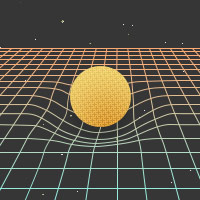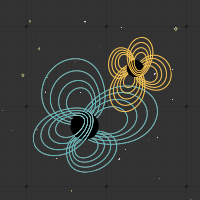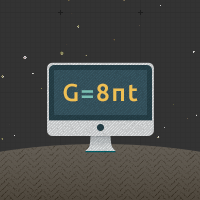Neutron Stars and Pulsars
The Beacons of the Universe
Keep piling on more weight, and at some point the electrons and protons in a white dwarf are crushed together and neutralize each other. The star turns into one big soup of neutrons. The gravity keeps pulling down, as before, pushing the neutrons closer together than they could ever get with the electrons and protons around.
This is where Nature's trickiness comes in. The neutrons also belong to the special category of particles called fermions. Like white dwarfs, neutron stars weigh about as much as our Sun, but they are packed into spheres that are just a few miles across. Imagine all the matter in the Sun — about 500,000 times as much as is in the Earth—being packed into a ball that could fit comfortably inside the Grand Canyon! This is 100,000,000,000,000 (one hundred million million) times as dense as lead.
With all this density, the gravity around a neutron star is much more intense than anything we on Earth will ever experience — just like in the case of the white dwarf, but worse. If you were separated at birth from a twin who went to live on the surface of a neutron star, by the time you reach 75 years old, your twin would only be 60 years old. (Of course, life on a neutron star is far worse than on a white dwarf, even.) In fact, gravity is so strong that not only the warping of time, but also the warping of space is noticeable. To visualize this warping, we take another disc slicing through the center of our star. But circles on the disc don't obey our high-school geometry rules. This disc that we cut straight through the star acts as though it is a hill, just like the one shown below.
 The dark ring shown in the picture represents the surface of the star. Take a rope reaching from the center of the star to its surface. If high-school geometry worked in this case, the circle would be about 6.2832 times as long as the rope. It turns out, however, that the circle is much smaller than that. That is the weirdness of warped space.
The dark ring shown in the picture represents the surface of the star. Take a rope reaching from the center of the star to its surface. If high-school geometry worked in this case, the circle would be about 6.2832 times as long as the rope. It turns out, however, that the circle is much smaller than that. That is the weirdness of warped space.
The picture above shows a perfectly round neutron star — it is the same, no matter which angle you choose to look at it. But this is not necessarily how stars found in the Universe actually are. Neutron stars are very complicated objects. For example, they are believed to have solid crusts — like the Earth's solid rock floating over the liquid magma inside. Just as there are mountains on the Earth, we can expect to find mountains on a neutron star. In that case, the star won't look the same from any angle. If we look at our disc now, it will act like a big hill, with a little lump on it.
Suppose that our bumpy neutron star is also spinning. We know that the Earth spins — that's why the Sun seems to move across the sky. Astronomers have seen that the other planets rotate similarly. Even the Sun itself rotates. We should expect that distant stars also rotate. As these stars die, their rotation doesn't just stop. Instead, like an ice skater bringing her arms in as she twirls, the collapsing star will spin faster and faster. Once the star is squeezed down to the size of a neutron star, it will spin incredibly quickly.
 Now we add one last ingredient to the mix. We know that the Earth has a magnetic field — which is why a compass works. Similarly astronomers have discovered magnetic fields around other planets, and even the Sun. Again, we would expect that most stars have magnetic fields. When the star contracts to the size of a neutron star, the magnetic field is squeezed and becomes much more intense. A typical neutron star might have a magnetic field 1,000,000,000,000 (one million million) times more intense than the Earth's. Such a strong magnetic field can shoot particles from the star out into interstellar space.
Now we add one last ingredient to the mix. We know that the Earth has a magnetic field — which is why a compass works. Similarly astronomers have discovered magnetic fields around other planets, and even the Sun. Again, we would expect that most stars have magnetic fields. When the star contracts to the size of a neutron star, the magnetic field is squeezed and becomes much more intense. A typical neutron star might have a magnetic field 1,000,000,000,000 (one million million) times more intense than the Earth's. Such a strong magnetic field can shoot particles from the star out into interstellar space.
In 1967, the astronomer Jocelyn Bell was looking at data she had been taking at a radio telescope when she noticed an unusual, steady pattern. Dr. Bell had discovered the first known pulsar. A pulsar is just a neutron star that shoots out a beam of particles and light. When the star rotates, its beam rotates with it, like a tremendous lighthouse. It may happen that the beam from this lighthouse sweeps across the Earth, where humans see the signal as a flash from outer space. Some pulsars flash hundreds of times per second. That means that the entire star is spinning around hundreds of times per second.
Now, if such a pulsar happens to also have a mountain on it, spacetime will get stirred up. Like a paddle spinning in water, that pulsar will give off gravitational waves. The spinning should be pretty constant, so we would expect the sound of its gravitational waves to be a very steady tone — one single, constant note carried off through space and time.
Listen to the steady tone of a pulsar, spinning almost endlessly in space






